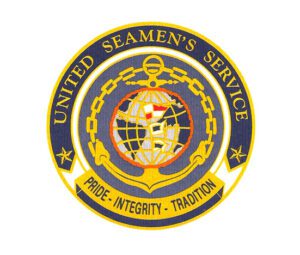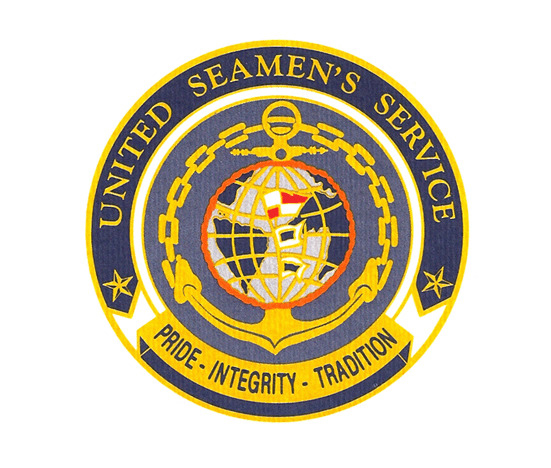
The officers and crew of four American-flagged vessels were recognized for heroism at sea at the United Seamen’s Service’s 53rd annual Admiral of the Ocean Sea (AOTOS) Award ceremony.
The event was held Oct. 28 in Manhattan, NY. The Honored Seafarer AOTOS Mariners plaques went to:
USNS Yuma (T-EPF 8), Military Sealift Command, Eastern Mediterranean Sea Sept. 1, 2022
A humanitarian disaster was averted and the life of an infant saved as the USNS Yuma was on routine operations when it received a call to assist. The ship headed to the scene where a Maltese tanker, the MT Nore, was struck by a distressed vessel carrying migrants it was towing was taking on water following the accident.
With more than 90 migrant men, women and children, on board, the vessel had begun sinking following the collision.
USNS Yuma, joined by Italian warship ITS Libeccio, deployed its rigid inflatable boat to render assistance, rescuing 35 male migrants who were provided life jackets, food, water and basic medical care.
Families were pulled aboard Libeccio, where they had a four-month-old girl who was reportedly ashen and responsive. USNS Yuma, at Libeccio’s request, raced its MilDet nurse practitioner over, then made another shuttle run with medical supplies. The medical officer was able to stabilize the baby before returning to USNS Yuma.
All the migrants were rescued and the 35 aboard the USNS Yuma were transferred to a Maltese patrol boat while Libeccio, with the other 58, raced toward Italy where a MEDIVAC flight could pick up the critically ill child. The Yuma resumed its patrol in the U.S. 6th Fleet Area of Responsibility.
“The seamanship, professionalism and selflessness of the crew of USNS Yuma is representative of the thousands of civil service mariners who are sailing ships for the U.S. Navy’s Military Sealift Command,” the United Seamen’s Service said.
M/V CMA CGM Herodote, Off the Coast of Japan, March 21, 2022
The American-flagged container ship CMA CGM Herodote was sailing from Saipan to Japan on March 21 when it saw smoke on the horizon and Ship Master Donald Moore changed course to investigate.
Eight nautical miles away, the Herodote discovered a Japanese fishing vessel, the Yuujin Maru 51, completely engulfed in flames. The 55-foot fishing trawler was burned from the superstructure to the waterline eradicating visible name and designating marks, and the Herodote saw no signs of survivors.
The Herodote launched a search pattern 100 miles off the Japanese coast near Tanegashima Island, Japan to scan the area for signs of survivors, while calling for assistance from other merchant vessels in the area and the U.S. Coast Guard Command Center in Hawaii, while coordinating with the Japan Coast Guard.
The m/v Woodside Rogers, a Greek-flagged tanker, responded, assisting in the search.
The Herodote searched for seven hours, spotting three fishermen in the frigid waters. The three were the only survivors of a crew of eight. The Greek tanker transported the men to safety.
Captain Donald Moore and his CGA CGM Herodote crew were awarded the Coast Guard Certificate of Merit award by U.S. Coast Guard Sector Guam. The award was presented at Coast Guard Micronesia Sector headquarters in Guam by USCG Captain Nick Simmons.
“The efforts of Capt. Moore and his crew honor the nautical tradition of assisting fellow mariners,” Simmons said in praise of the Herodote crew. “Their bias for action and commitment were on display that day.”
S/S Pacific Tracker, 500 Miles West of California, July 10-12, 2022
The S/S Pacific Tracker was sailing off the coast of California when a call came from the Coast Guard Rescue Coordination Center Alameda to locate the sailing vessel S/V Perplexity somewhere more than 500 nautical miles off the coast. Aboard the Perplexity was an injured sailor bleeding uncontrollably, too far from the Southern California coast to be reached by helicopter.
S/S Pacific Tracker made a turn and began the search for the tiny sailing vessel about 100 miles away. The Pacific Tracker, a research/survey ship operated by TOTE Services, is used in gathering telemetry for ballistic missile tests, was looking for the proverbial ‘needle in the haystack’ to locate the Perplexity, which had been participating in a race, and rescue the sailor. Hours later, at about 6:45 pm local time, success: the six meter by one meter sailing vessel was in sight.
Launching a fast work boat, crew from the Pacific Tracker plucked the seaman, who had been experiencing an uncontrolled nosebleed for several days, from the sailing boat and on board the much larger vessel.
The sailor’s condition was immediately stabilized, while the vessel turned toward the California coast to facilitate a MEDEVAC transfer. While the Pacific Tracker was steaming to the shoreline, its crew was in contact with the U.S. Coast Guard and doctors.
Once closer to the coast, during the mid-morning of July 12, a Coast Guard helicopter reached the S//S Pacific Tracker and MEDIVACED the now stable patient and transferred him to a shoreside hospital.
“The actions of the S/S Pacific Tracker crew is in the highest dedication to maritime safety and rescues, and reflects great credit upon the Missile Defense Agency, the Maritime Administration and the U.S. maritime industry,” the United Seamen’s Service said in a statement.
M/V Maersk Peary, Aegean Sea north of Crete, Dec. 22, 2021
The American tanker was steaming across the Aegean Sea north of Crete enroute to the Suez Canal the evening of Dec 22 when Rescue Center Piraeus in Greece requested urgent assistance finding a capsized vessel with about 80 people on board.
The Maersk Peary was less than 14 miles from the downed vessel, and made immediate course changes to enter a search grid established by Greek Coast Guard, arriving in minutes. The ship’s master, Everett Hatton, began maneuvering slowly into the zone while his crew mobilized a launch crew with its rescue boat. An hour into the search, with searchlights scanning the waters, Capt. Hatton spotted a white object in the water.
The ship’s third mate and boatswain zeroed in on the object with binoculars as the 590-foot Maersk Peary cut its engine, launched the rescue boat loaded with blankets and proceeded toward the object later identified as a boat fender and found a survivor clinging to it. The chief mate tried to communicate with the man, but the exhausted person was shivering and unable to speak. He was pulled from the chilly waters and onto the rescue boat.
With 15 minutes, about 10:30 pm local time, the Maersk Peary rescue boat linked up with the Greek Coast vessel OSP707 and transferred the survivor. The American ship continued its grid search for another four hours before being relieved by Greek Search and Rescue Command.
Authorities rescued 62 of the estimated 80 migrants aboard the sinking boat. Sixteen bodies were recovered from the water. The migrants are believed to have sailed from Turkey.
Capt. Hatton lauded his Maersk Peary crew for their professionalism and rapid response to an emergency situation. The vessel had just finished loading fuel to be delivered to McMurdo Sound in Antarctica.
Since the start of the AOTOS Award in 1970, the United Seamen’s Service has honored more than 300 American vessels and individual seafarers for heroism, also called “the brotherhood of the sea.”

